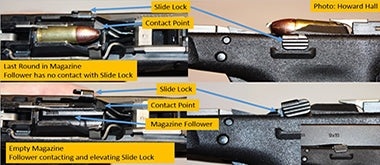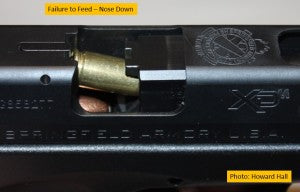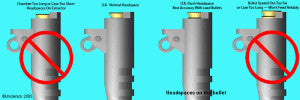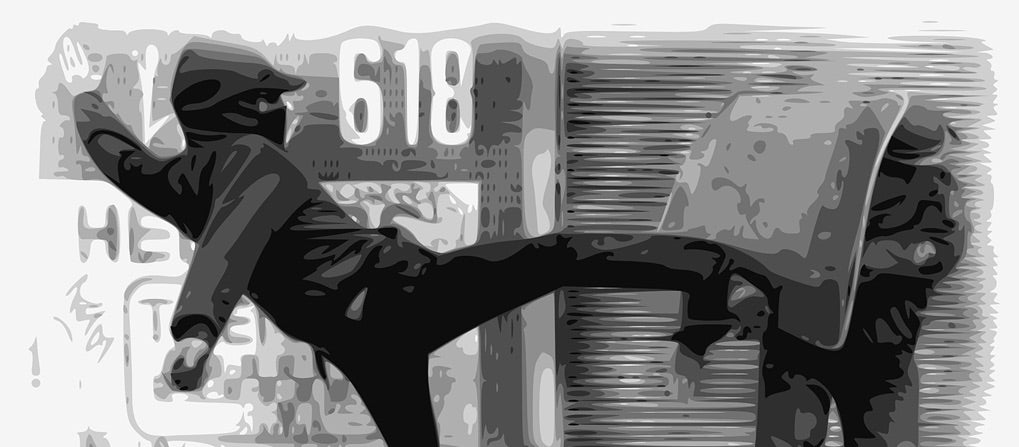
Diagnosing Pistol Malfunctions – Part I: Failure to Feed
Diagnosing Pistol Malfunctions – Part I: Failure to Feed
Whether on the range or via e-mail, I receive a lot of questions regarding pistol malfunctions. These questions go beyond discussing the skills required to clear malfunctions. They are geared more toward understanding “what” makes their pistol malfunction and what can be done to prevent the malfunction, rather than just relying on corrective actions alone. There is a lot of material to cover in regard to diagnosing pistol malfunctions, so I’ll break the topic into a three-article series. In general, there are three main types of malfunctions: (1) failure to feed; (2) failure to fire; and (3) failure to extract/eject. This first article: “Diagnosing Pistol Malfunction – Part I” will provide an in-depth discussion on failure to feed.
Cycle of Operations
I chose failure to feed since it is arguably the start of the cycle of operations. Internal Ballistics Part I listed detailed descriptions on each of the elements in the cycle of operation, which are: Feeding, Chambering, Locking, Firing, Unlocking, Extracting, Ejecting, and Cocking.
To be more specific on the definition of failure to feed, we will look closely at a semi-automatic pistol’s operation from the point of full slide recoil through the forward motion that strips the cartridge from the magazine, chambers the round, and locks into battery. This discussion will cover the majority of possible malfunctions or interruptions of the first three elements in the cycle of operations.
Slide Lock Malfunctions
Since we are starting this discussion from the point of full rearward slide movement, the first thing that can prevent the slide’s movement forward is an unanticipated slide lock engagement. Although it is easy to clear this malfunction, it is very frustrating and can cost precious seconds in a live engagement or competition.
When things are working properly, a small tab on the top left side of the magazine follower engages the portion of the slide lock protruding into the interior of the frame. As the last round is stripped from the magazine, the follower moves to the highest position in the magazine. Once that last round is fired and ejected, the follower pushes the slide lock protrusion and slide lock body up and into a small cut-out in the slide, thus locking it to the rear. Click the image below for a larger view.

When things aren’t working properly, the slide lock moves “up,” engages the slide while there are still cartridges in the magazine. Most pistols have an internal spring connected to the slide stop assembly which prevents inadvertent upward movement. 1911 style pistols have an external spring and plunger that provide friction against the face of the slide stop to prevent inadvertent engagement. If the malfunction is within the pistol, it may be due to a damaged or weak slide stop or plunger spring (1911). Otherwise, this can occur due to a magazine that is damaged or out of specification.
Most shooters don’t want to hear this, but the primary cause of premature slide-lock is shooter induced. I’ve heard shooters swear up and down that they are not the cause, only to find out that one of their thumbs “gently grazed” the slide stop and moved it upward during recoil.
If you are having this malfunction: (1) make sure it is not shooter induced; (2) check the magazines for proper contact with the slide stop; and (3) check the slide stop spring or the plunger spring in 1911s.
Cartridge Not Stripped From Magazine
This occurs when a round is fired, the case was extracted and ejected properly, but the next round is not stripped from the magazine leaving the slide to move forward and lock on an empty chamber. I’ve seen this a lot and it has happened to me on occasion during USPSA shooting.
Magazine improperly seated – Many of us have been there… we receive the command to “make ready,” so we insert a magazine, pull the slide to the rear and chamber a round, conduct a chamber check to ensure that a cartridge was chambered, apply the safety, holster, and wait for the signal to start firing. We hear the “beep,” unholster, index the first target, press the trigger, and send the first round down range. However, our second trigger press is met with a “click,” followed by any number of expletives. While we verified that the first cartridge was chambered, without ensuring that the magazine was fully seated, the slide simply “skipped over” the next cartridge instead of stripping it from the magazine and chambering it. A simple “tap” on the bottom of the magazine followed by racking the slide sets everything straight… most of the time.
 In some cases, however, the problem is not shooter error, but is caused by the mechanical interaction within the pistol. There is a small cut-out in the magazine that contacts the internal surface of the magazine catch and locks the magazine in place within the frame. If the magazine is damaged in the vicinity of the cut-out, the magazine catch itself is damaged, or if there is dirt/debris blocking the magazine well, the magazine may not fully seat, which will cause the slide to “skip over” and completely miss the next cartridge in the magazine.
In some cases, however, the problem is not shooter error, but is caused by the mechanical interaction within the pistol. There is a small cut-out in the magazine that contacts the internal surface of the magazine catch and locks the magazine in place within the frame. If the magazine is damaged in the vicinity of the cut-out, the magazine catch itself is damaged, or if there is dirt/debris blocking the magazine well, the magazine may not fully seat, which will cause the slide to “skip over” and completely miss the next cartridge in the magazine.
Chamber Feed Failure – Nose Down
 This occurs when the tip of the cartridge impacts the feed ramp on the frame or barrel at a downward angle, fails to feed into the chamber, and halts the motion of the slide… thus jamming the pistol.
This occurs when the tip of the cartridge impacts the feed ramp on the frame or barrel at a downward angle, fails to feed into the chamber, and halts the motion of the slide… thus jamming the pistol.
There are a number of potential causes for this type of malfunction which include the magazine, the extractor, the feed ramp, and the cartridge itself. Let’s start with a discussion on the magazines. As we covered in the section above, an improperly seated magazine can cause the slide to fully “skip over” the next cartridge in the magazine. That is true when the magazine is seated so low that the breech face of the slide doesn’t even come in contact with the base of the cartridge. However, if the magazine is seated low or if the follower isn’t pushing the cartridge as high as it needs to be, the breech face of the slide will contact only the upper edge of the cartridge base which can: (1) cause the case rim to glide under the extractor as it slides up the breech face; and/or (2) can start the cartridge’s forward movement toward the chamber in a “downward” attitude.
Now, let’s talk about the extractor. While most shooters are very familiar with the primary purpose and function of the extractor, not as many understand the role it plays in the feeding and chambering process. As the slide moves forward and the breech face contacts the next cartridge in the magazine, the base of that cartridge moves “up” the breech face, positioning the primer in front of the firing pin/striker, guided and firmly held in place by the extractor. Improper extractor tension (too tight or too loose) can prevent the cartridge case from properly aligning with the chamber as it is stripped from the magazine.
 At this point, we’re left with the feed ramp and the cartridge. In regard to the feed ramp, there are two types of barrel construction: (1) “ramped” with the feed ramp incorporated into the barrel design; and (2) standard where the feed ramp is part of the frame. If the feed ramp is damaged or corroded in either design, or if there is a misalignment or seam in the two part design, there may be sufficient friction present when the cartridge nose contacts the feed ramp that halts forward momentum.
At this point, we’re left with the feed ramp and the cartridge. In regard to the feed ramp, there are two types of barrel construction: (1) “ramped” with the feed ramp incorporated into the barrel design; and (2) standard where the feed ramp is part of the frame. If the feed ramp is damaged or corroded in either design, or if there is a misalignment or seam in the two part design, there may be sufficient friction present when the cartridge nose contacts the feed ramp that halts forward momentum.
 The last place we can look is cartridge design, which can vary by projectile design and overall length. Short and blunt tipped cartridges have a greater tendency to feed nose-down. This is due to both the greater distance between the tip of the projectile and the feed ramp (i.e. further distance to travel) and the shape of the surface that strikes the feed ramp. Longer cartridges with a rounded projectile tend to feed more reliably.
The last place we can look is cartridge design, which can vary by projectile design and overall length. Short and blunt tipped cartridges have a greater tendency to feed nose-down. This is due to both the greater distance between the tip of the projectile and the feed ramp (i.e. further distance to travel) and the shape of the surface that strikes the feed ramp. Longer cartridges with a rounded projectile tend to feed more reliably.
If you are experiencing a nose down failure to feed, check your magazines, extractor tension, feed ramp, and cartridge construction, to include overall length. In many cases, keeping the magazines, feed ramp, and extractor (especially under the extractor hook) clean can alleviate many of these problems.
Chamber Feed Failure – Nose Up
 When the cycle of operations is abruptly stopped by a cartridge jammed in a nose-up attitude, the most likely culprits are the magazine, extractor, and chamber. Similar to the nose-down attitude, a damaged magazine is the most likely cause of the nose-up feed fail. This typically occurs when the magazine spring tension is so great that it causes the cartridge to literally “jump” out of the feed lips… or the feed lips are damaged or distorted to the point that they can no longer hold the cartridge in proper alignment for a straight shot into the chamber.
When the cycle of operations is abruptly stopped by a cartridge jammed in a nose-up attitude, the most likely culprits are the magazine, extractor, and chamber. Similar to the nose-down attitude, a damaged magazine is the most likely cause of the nose-up feed fail. This typically occurs when the magazine spring tension is so great that it causes the cartridge to literally “jump” out of the feed lips… or the feed lips are damaged or distorted to the point that they can no longer hold the cartridge in proper alignment for a straight shot into the chamber.
Again, the extractor must be considered due to the role it plays in proper cartridge alignment. If the extractor tension is too tight or too loose, it will not hold the cartridge in place for proper forward motion.
The condition of the chamber may also cause this malfunction. After the nose of the cartridge contacts the feed ramp and continues into the chamber, the nose can “skip up” and contact the top of the chamber near the barrel hood. If there is damage, pitting, or excessive carbon build-up, friction can halt the forward momentum of the cartridge and jam the weapon.
Failure to Return to Battery
In these instances, everything has worked properly in feeding and chambering, but the pistol fails to lock, or return to battery. The first thing you’ll notice is that the pistol won’t fire. The second thing you’ll notice is that the slide isn’t all the way forward either. This can often be attributed to ammunition that is out of specification (too long), a weak recoil spring, or excessive carbon build-up/debris in the chamber.
 If the cartridge is too long or there is excessive carbon or dirt in the chamber, the cartridge will not seat fully into the chamber and the base of the cartridge will extend beyond the barrel hood and push against the breech face, thus keeping the slide out of battery. Excessive carbon or dirt lodged between the locking lugs of the barrel and their corresponding cut-outs in the slide can also prevent a full return to battery.
If the cartridge is too long or there is excessive carbon or dirt in the chamber, the cartridge will not seat fully into the chamber and the base of the cartridge will extend beyond the barrel hood and push against the breech face, thus keeping the slide out of battery. Excessive carbon or dirt lodged between the locking lugs of the barrel and their corresponding cut-outs in the slide can also prevent a full return to battery.
In some cases, a simple tap to the rear of the slide can nudge the pistol into battery. If this occurs, it may indicate a weak recoil spring, excessive carbon/dirt in the slide rails, or both. In most pistols, the recoil spring is the longest and it experiences the greatest degree of compression and expansion with every shot fired. Therefore, it is the one spring that should be changed most often. How often? Well, performance should be the ultimate indicator, but Wolff Gunsprings Inc. recommends replacing the recoil spring every 1,500 rounds. I believe that is a bit conservative and put the number closer to 5,000. Regardless, a recoil spring of proper tension will allow the slide to recoil fully and return to battery with enough force to overcome a modest amount of dirt, debris, and even cartridge misalignment.
Conclusion
A great majority of these failures are the product of excessive carbon or dirt build-up, worn-out parts, or are shooter-induced. Proper cleaning and maintenance can reduce many of these malfunctions. Some of the more serious issues require the tools, experience, and skill of a gun smith. With the information in this article, however, you can take the first steps toward diagnosing the problem and effectively communicating it to the gun smith… saving both time and money.
Check-back with us next time for a discussion on Failure to Fire.
Until then, stay safe and shoot straight.
Leave a comment
Comments will be approved before showing up.
Also in Staff Articles

Home Defense - What you can do...

Gun Review: Sig Sauer P938



Howard Hall
Author